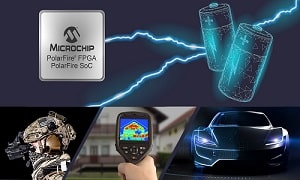The new low-density PolarFire devices consume half the static power of alternatives while providing a small thermal footprint

Edge compute systems need compact programmable devices with low power consumption and a small thermal footprint to eliminate heat mitigation while providing robust compute horsepower.
Now Microchip Technology Inc. has solved this challenge by cutting static power consumption for its mid-bandwidth Field Programmable Gate Arrays (FPGAs) and FPGA System-on-Chip (SoC) devices in half and giving them the smallest thermal footprint and best performance and compute horsepower compared to all alternative devices in their class.
“Our new PolarFire FPGAs and FPGA SoCs reduce our customers’ system costs while enabling them to solve difficult thermal management challenges without having to forfeit bandwidth,” said Bruce Weyer, vice president of Microchip’s FPGA business unit. “We have reduced power consumption by up to 50 per cent or more with the introduction of lower density offerings while maintaining best-in-class capabilities on these platforms.”
An ultra-low power consumption enables Microchip’s latest low-density PolarFire FPGAs (MPF050T) and PolarFire SoCs (MPFS025T) to exceed the performance/power metrics of any low-density FPGA or SoC FPGA alternatives in the market. With fast FPGA fabric and signal processing capabilities, these transceivers are class RISC-V architecture-based processor complex with 2 megabytes (MB) of L2 cache and Low-Power DDR4 (LPDDR4) memory support. Extending the portfolio with 25K logic elements multi-core RISC-V SoC and 50K logic elements, the FPGA opens new application possibilities. They are ideal for low-power smart embedded vision applications and thermally constrained automotive, industrial automation, communications, defence and IoT systems where neither power nor performance can be compromised.
The new PolarFire devices are complemented by a suite of Microchip devices for complete systems solutions for applications including smart embedded vision, machine learning, security, aerospace and defence, and embedded computing. They also provide plug-and-play solutions for power and timing designs.
“Microchip’s PolarFire FPGA solution expands our opportunities to innovate with our USB 3.2 video capture product line. It offers ideal dimensions, industry-low power consumption and a unique combination of mid-range transceivers, logic, DSP and RAM resources,” said Nick Ma, CEO and CTO at Magewell.
“Microchip’s SmartFusion 2 and PolarFire FPGAs provide us the best balance between small form factor, power efficiency and processing resources required to support embedded algorithms like shutter-less compensation and image enhancement within an extremely low power budget in our current and next-generation product portfolios,” said Frederic Aubrun, CCO of Xenics.
“The PolarFire FPGA-based Iron cameras utilise the FPGA’s small form factor and low-power performance to offer a compact outline that can be fitted into tight spaces while presenting the magnificent quality of the most advanced global-shutter CMOS sensor with excellent low-light performance,” said Michael Yamposkly, Founder and CEO of Kaya Instruments.
Developers can begin designing with Microchip’s PolarFire FPGAs and FPGA SoCs now using the company’s recently released Libero 2021.2 software tools, which are available on the company’s website. Volume shipment of production silicon is scheduled for the first calendar quarter of 2022.





